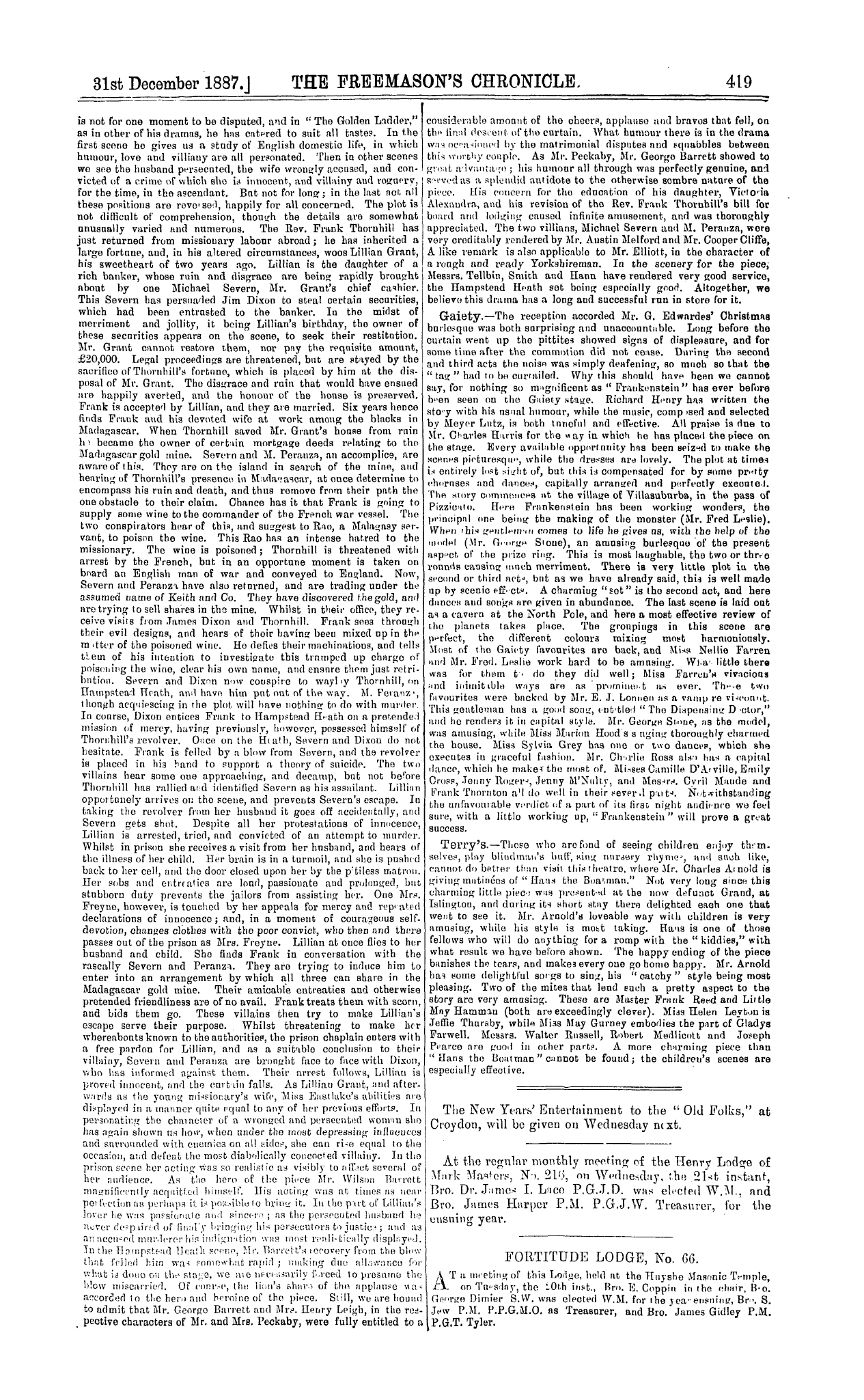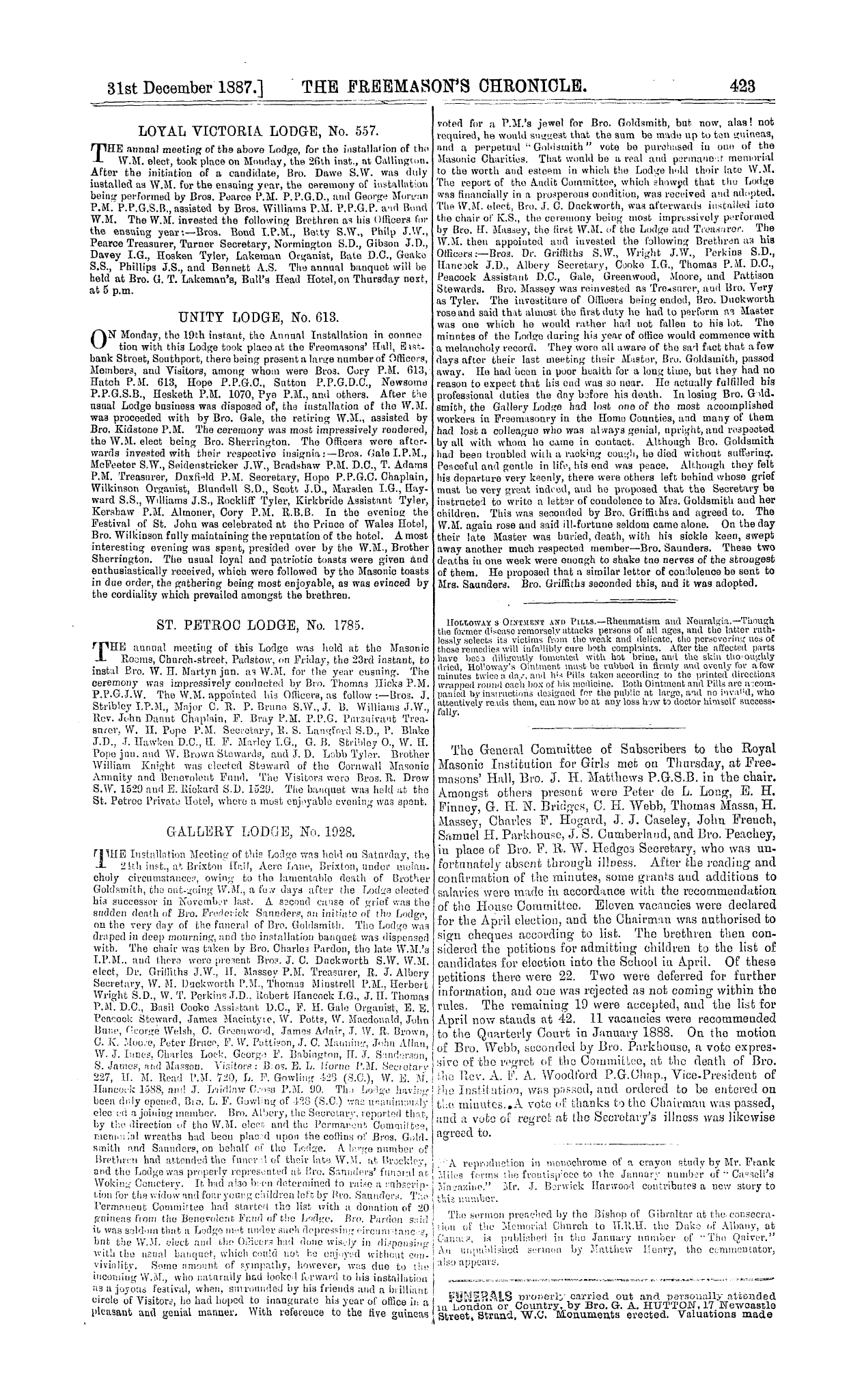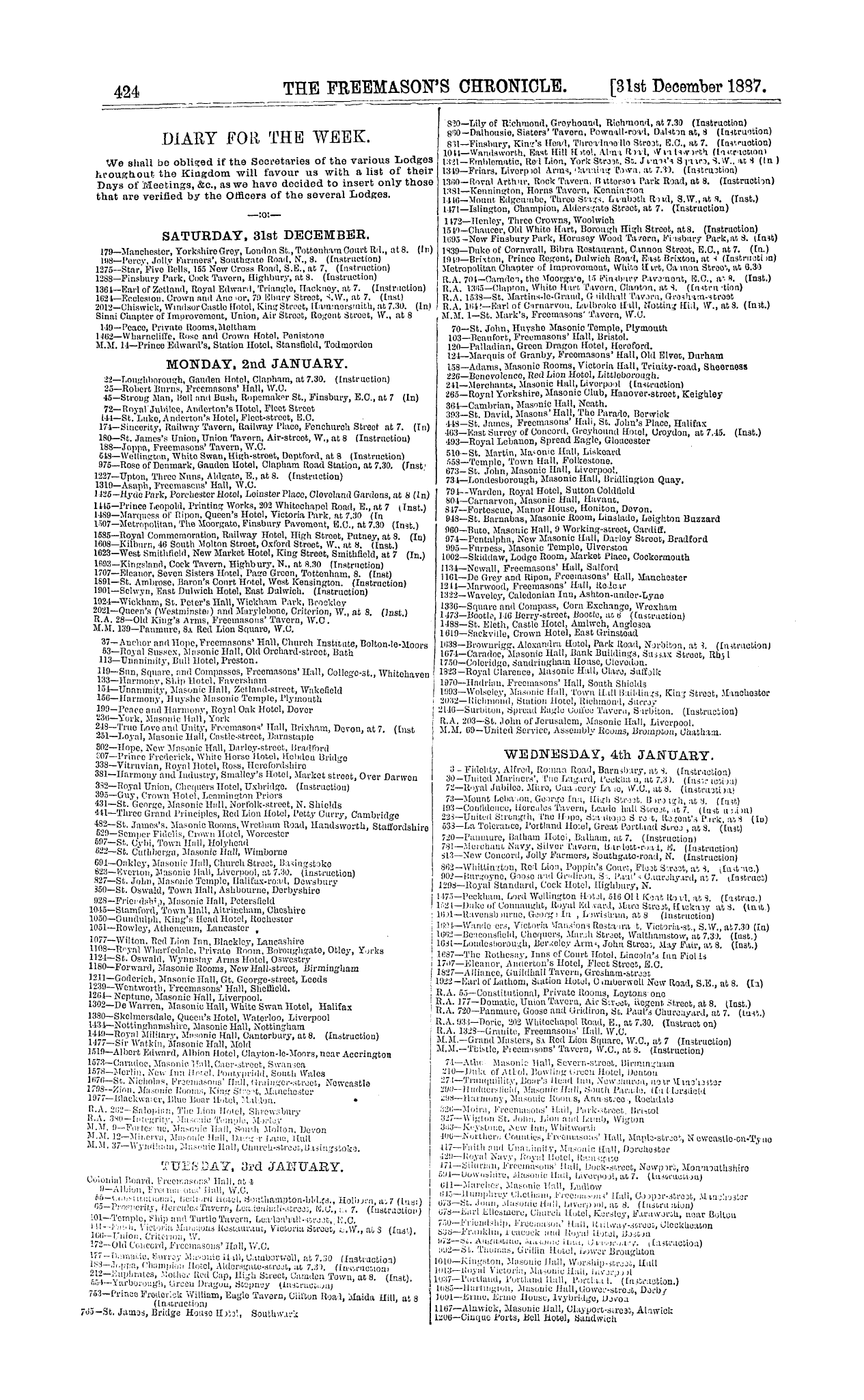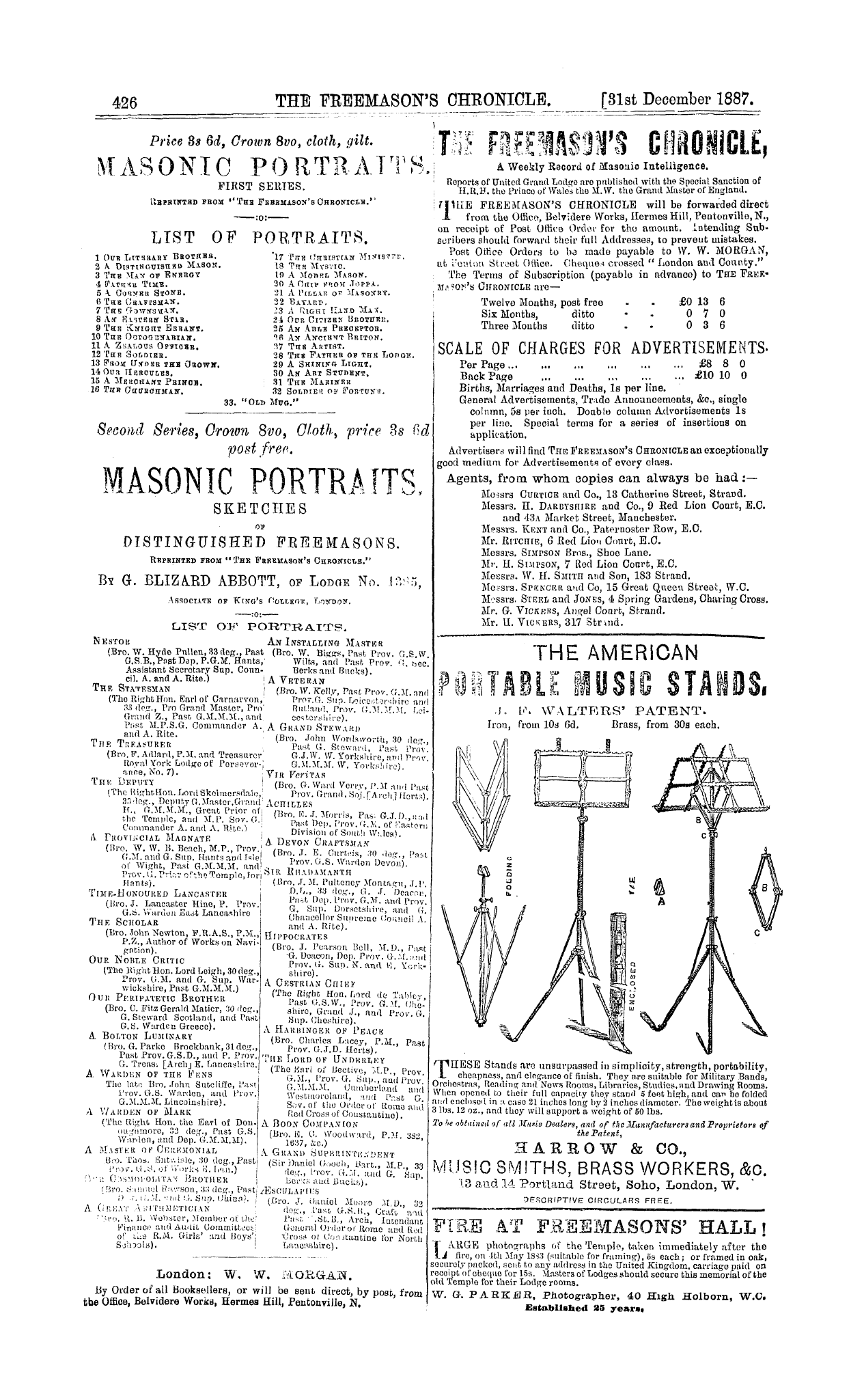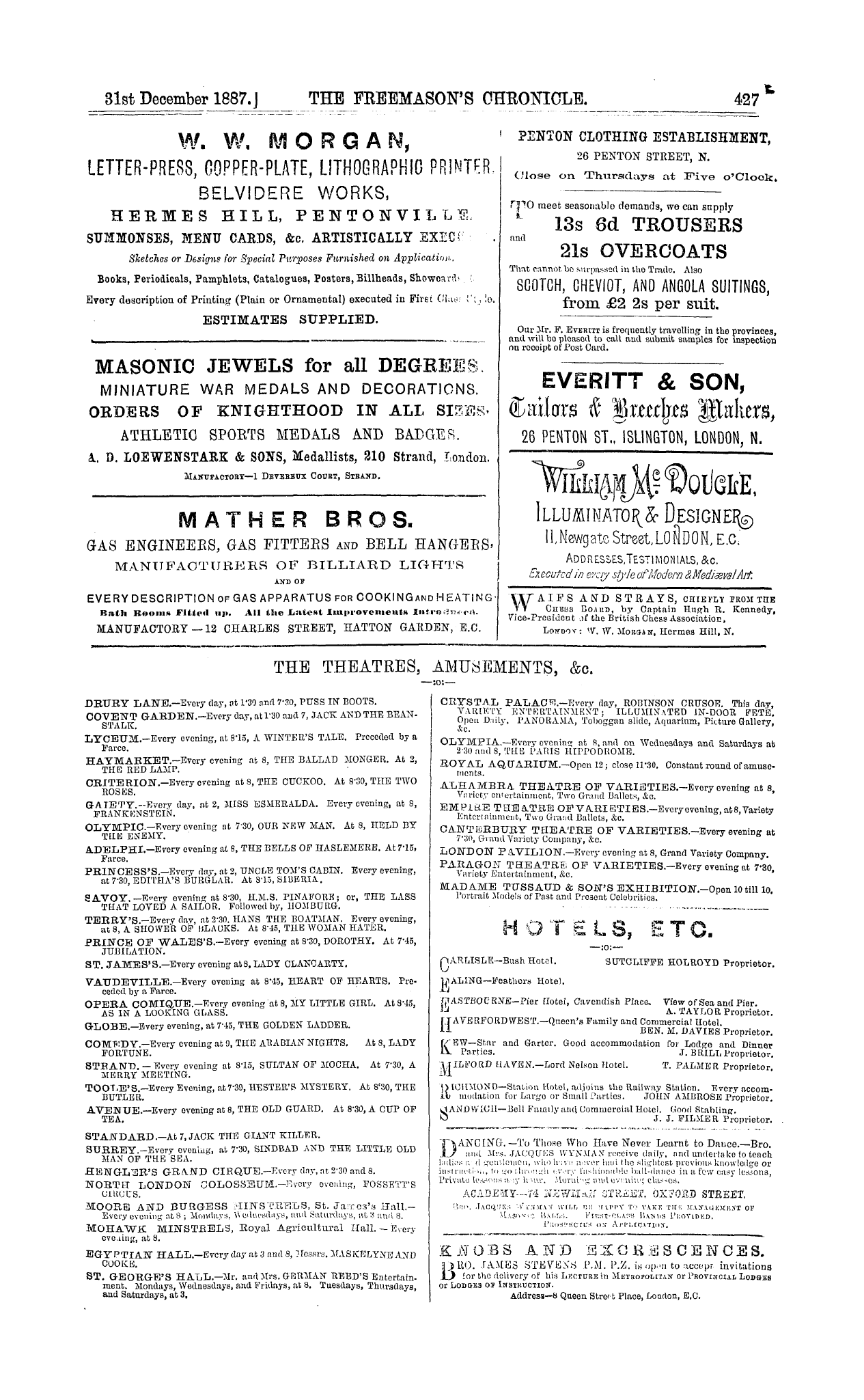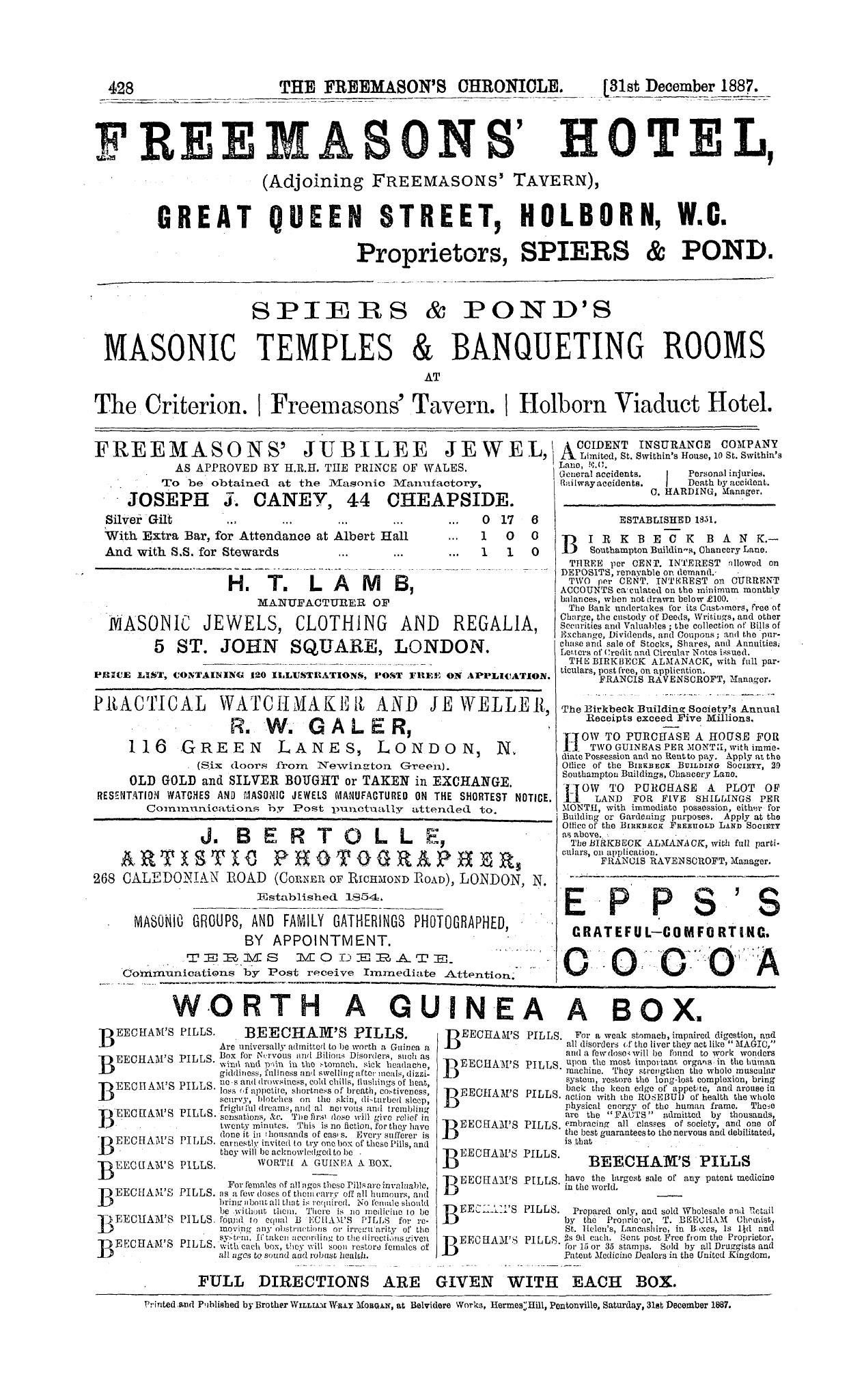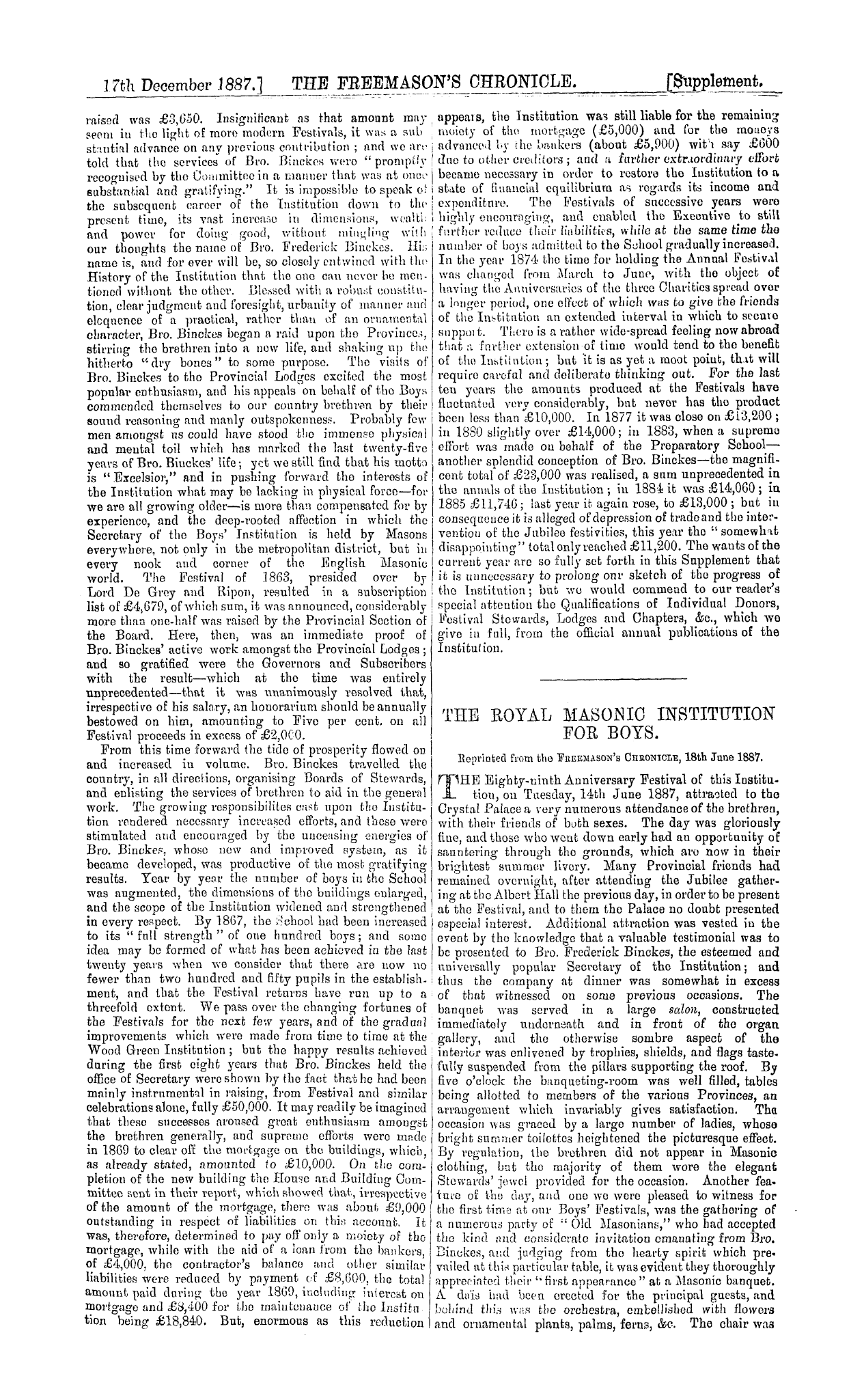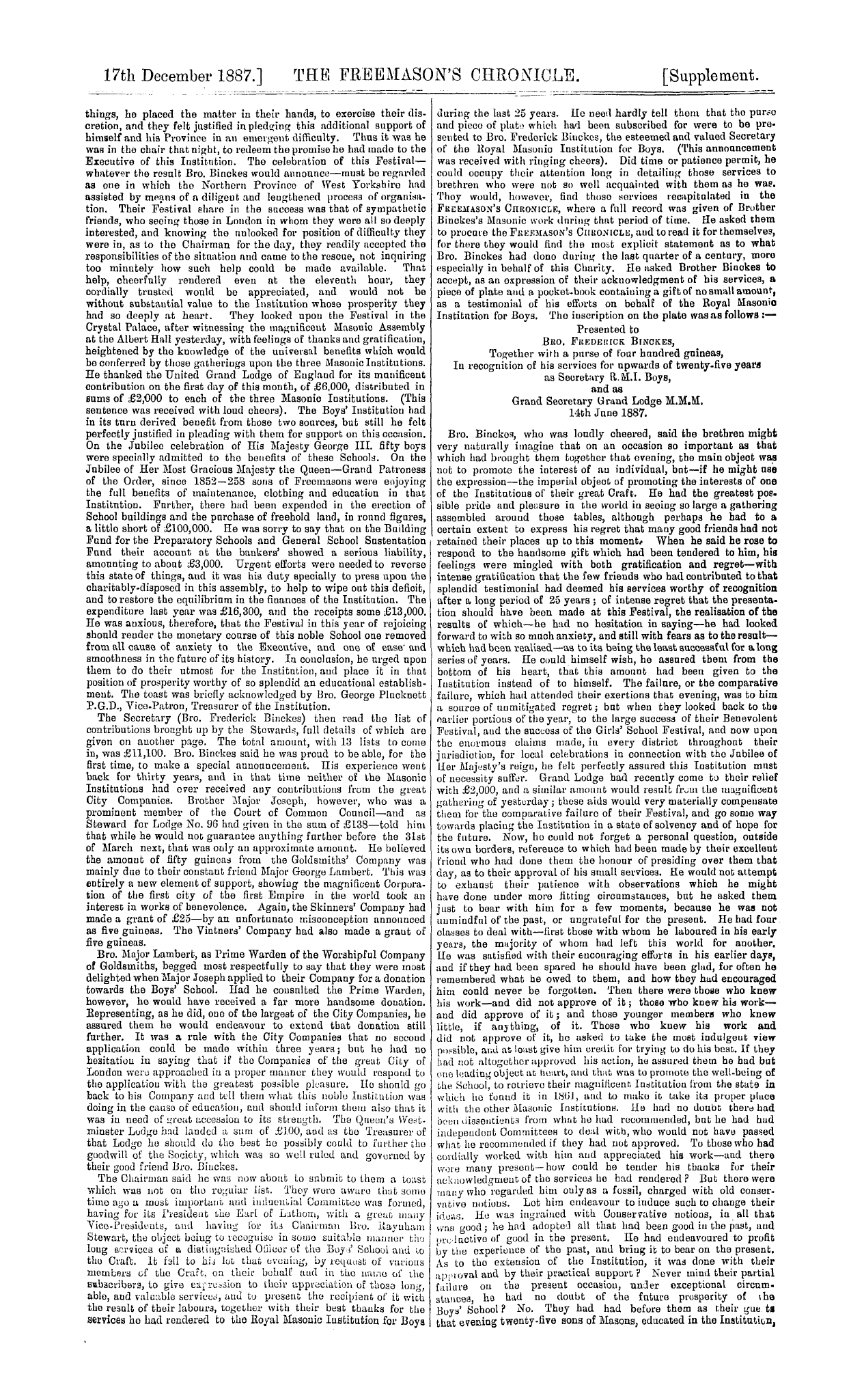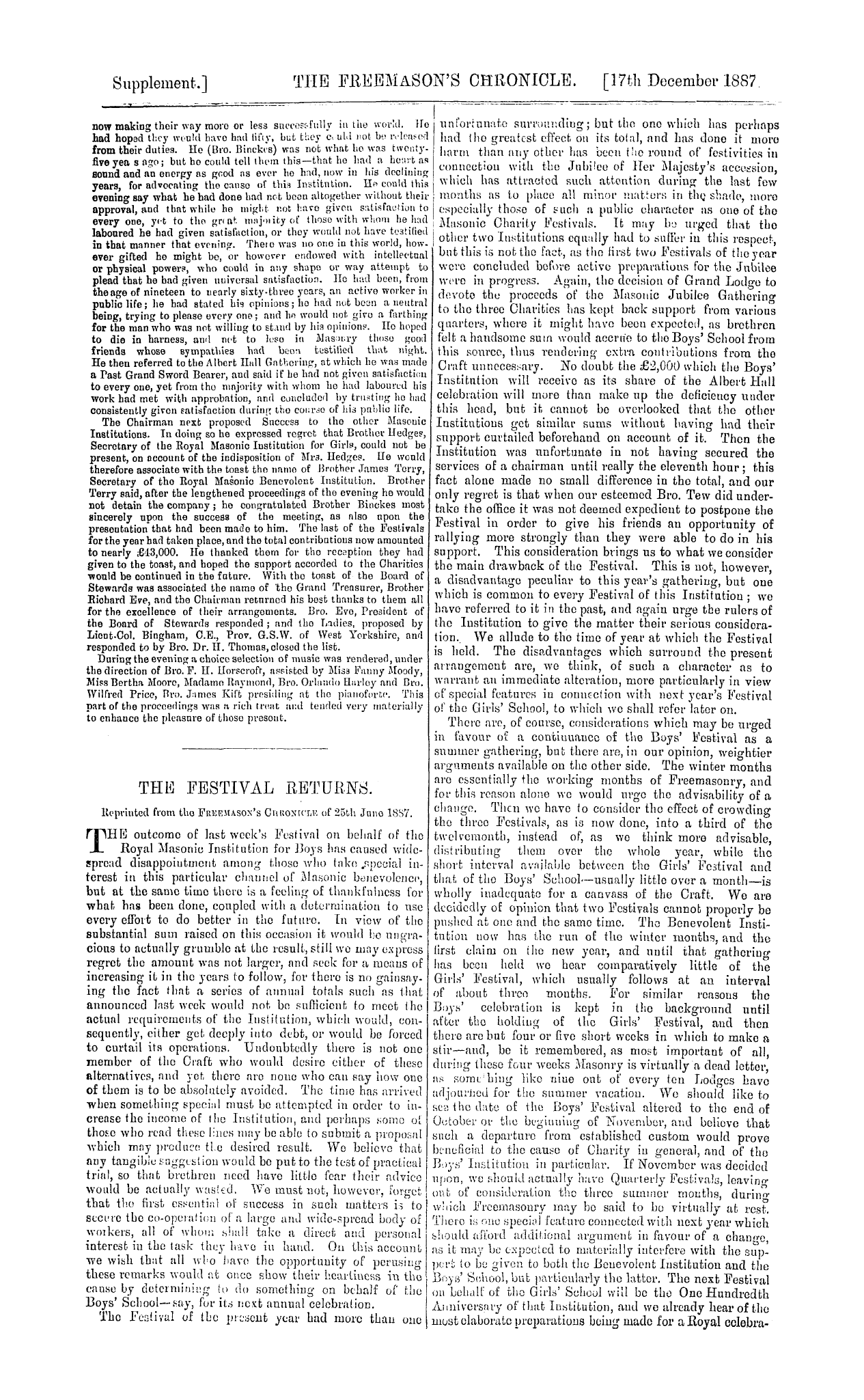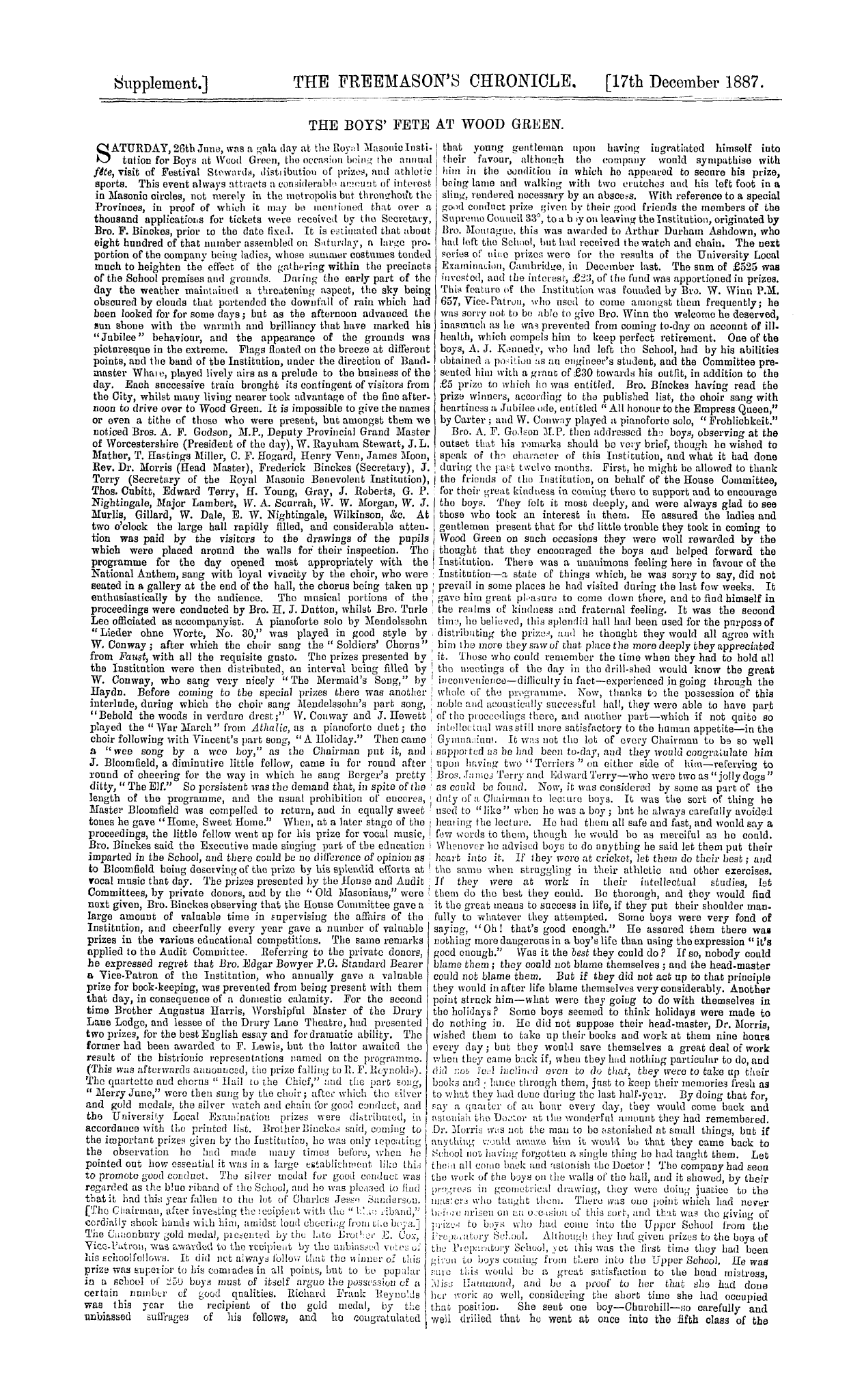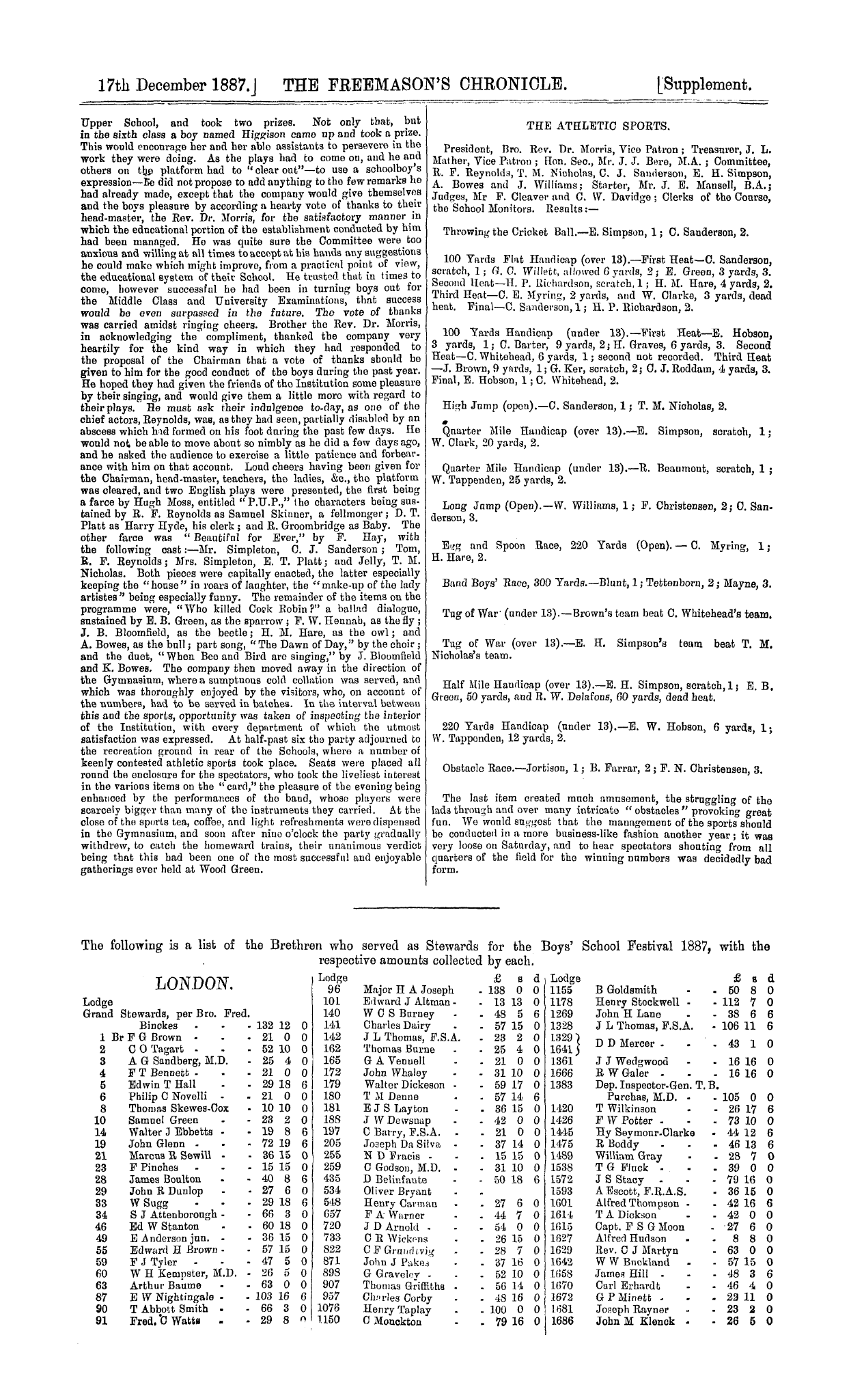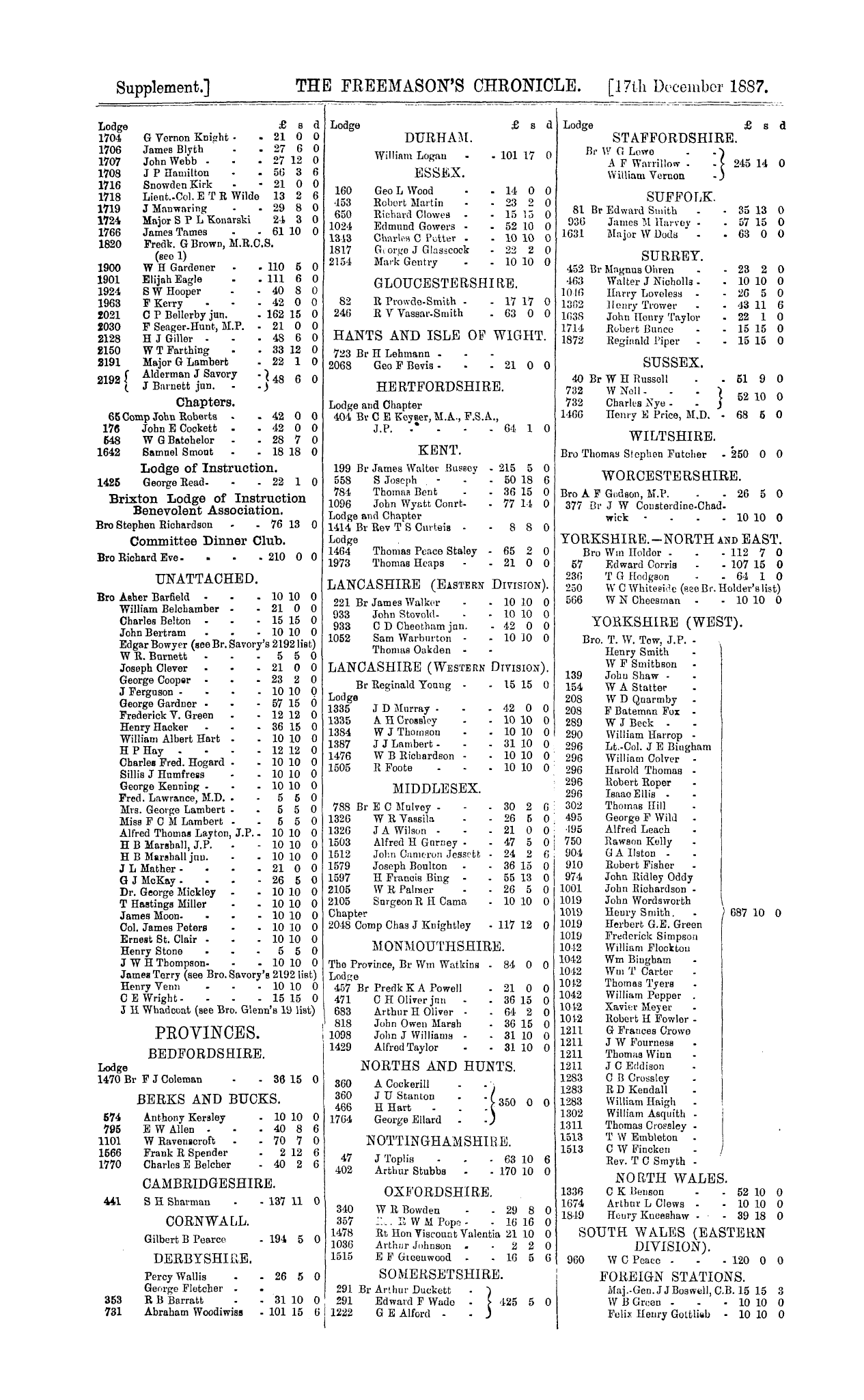-
Articles/Ads
Article HIRAM LODGE. ← Page 2 of 3 Article HIRAM LODGE. Page 2 of 3 →
Note: This text has been automatically extracted via Optical Character Recognition (OCR) software.
Hiram Lodge.
Now this Resolve tells the story , does it not , between the Grand Lodge and Hiram Lodge ? and it is not subject to addition or abatement .
It was evidently , in the lig ht of the concurrent facts which we have exhibited , a compromise , to which both parties assented , and with which they were satisfied .
The Grand Lodge endeavoured to have all these old charters surrendered or given up fco it , but they had not been successful . Hiram Lodge was the oldest , largest , wealthiest and most influential Masonic body in the jurisdiction .
They wanted Hiram Lodge in their organisation . It was exceedingly active and prompt , and efficient in all Masonic duties . They wanted Hiram Lodge , its activity and enterprise , its able and accomplished men , their labour and
sympathy and support . They were ready to give up something , and they did g ive up something . They allowed Hiram Lodge to take back , or rather to keep its old charter , without any conditions . They did not stipulate that it should lio dormant or in abeyance .
Grand Lodge did not provide or suggest that its own charter should have precedence in authority or rank ; it did not intimate , and we cannot " presume " that tho "
possession of the old charter was only permitted as an heirloom . " There is no such fact in tho Resolve , in any record of the history , or in any certificate of Grand Master or Grand Secretary .
It were easy to have made such a stipulation if they meant it;—easy to have indorsed upon the charter that it was only "memorial , " or an "heirloom , " or to be kept not as authority but of favour , or a thousand other
conditional and limiting certificates if they had wanted and meant it , if they had made any . But the whole evidence is plain , unequivocal , decisive . They made no conditions , they could make none , and the action on either side is consistent with the evidence .
The Grand Lodge charter to Hiram Lodge although , as we believe , not issued till 1796 , still reaches back and gives that Lodge the rank of seniority , which it had had
continuously before that time . And it has stood upon their roll ever since as " No . 1 . " In a word , Grand Lodge by these acts made a legal confirmation of the' Oxnard Charter , and recognized aud avouched its validity .
Better , as it seems perhaps to-day , that they should not have passed the Resolve , or done the deed as they did ; but not so , this even is not beyond question , for it would certainly seem that by the action of Hiram Lodge in 1796
they secured during the next year the constituency of the old Daubeny and Guilford Lodges—a result not fco be lightly estimated . But better or not , they did it , and we must stand by what they did .
There is another piece of legislation by this Grand Lodge which indirectly confirms the view we have taken . In this same year , 1796 , they passed a Resolve which recognises and permits precisely this relation which existed between it and Hiram Lodge , as follows : —
" Resolved , that this Grand Lodge will not hold communication or correspondence with any Mason or Masons , citizens of any of fche United States , Lodge or Lodges , who hold authority under and acknowledge the
supremacy of any foreign Grand Lodge , or who do not , by their representatives , communicate and pay their dues to the Grand Lodge of the State where they are constituted or where they reside . " ( Proc . p 82 . )
Hiram Lodge held under the authority of a Provincial Grand Master appointed from the Grand Lodge of England . They did " b y their representatives communicate and pay their dues to the Grand Lodge " of Connecticut , " where they were constituted , " and " where they did reside . "
thus by their own Resolve of general legislation , six years after the relation of Hiram Lodge had been defined by enacted resolution , the Grand Lodge acknowledge Hiram Lodge to be within the circle of full and unrestricted
communication and correspondence . Indeed , the Resolve seems to be almost felicitously worded to justif y and cover the relations of a Lodge standing as Hiram Lodge is supposed to have done .
If , however , the new charter of recognition was not actuall y taken out till this year , and the precise fact I am unable to verify , then ifc may well be said , that Hiram Lodge was unwilling to come into the desired and more
intimate connection of the Grand Lodge , except upon the unequivocal declaration of principal by that body , that they would consider a Lodge which , by their representatives , did . communicate and pay dues to them , as in full communion and correspondence , though they might hold
Hiram Lodge.
a charter granted by other authority than themselves , but this is only suggestion . These are tho facts , and all tho facts , so far as they appear of record iu the Proceedings of the Grand Lodge of Connecticut .
Tho rights and the duties of both parties would seem to be settled by the p lain and obvious sense of these recorded facts . It was in the power , and in the opportunity of the
Grand Lodge to have prevented all question . They could have required tho surrender and abolition of the Oxnard Charter . That would be the authorised and usual procedure in such cases .
But the Oxnard Charter was not suri'endered . It was not arrested . It was not by any agreement abolished or vacated of power . There does not appear even any effort by that name or to that end to have been taken .
Thero are , we submit , four ways only by which a lawful charter can be invalidated : b y arrest from tbe powor which granted it ; by surrender to some power qualified to
receive it ; by actual material destruction and obliteration , and by a disuse continued for so long a time that there shall not remain members of tho Lodge , held under its authority , enough to form a Lodge and use it .
Neither of these invalidations has place respecting the Oxnard Charier . The Lodge has had a continuous and active existence since 1750 , and has had all the time in
their possession and custody this uncancelled charter , this Oxnard Charter , not a word against whose continuous vitality has ever been uttered by Grand Lodge in all the years preceding the existing difficulty .
With these facts before us , let us look at Hiram Lodge , and consider her position in the matter . Suppose tho strongest case against her—that in 1790 or 1796 , upon tho receipt of her new charter from the Grand Lodge ,
she deliberately and purposely laid the Ancient Oxnard Charter aside , or only regarded it " as an heir-loom , " or piece of Masonic bric-a-brac , and that this estimate continued down to tho time of the difficulty . How does
this change the resultant fact ? We submit , not at all . Unless tho charter was by some lawful authority devitalized , or divested of potency , its vital and potential
ability must abide in ifc and with ifc , and equally whether de facto used as the Lodge authority , or permitted to sleep while some other authority was practically adequate and was put to tbe front .
An example of fact will make the position perfectly simple . A man has a watch that he has carried for years , and is in all respects an excellent time-keeper , and in perfect
repair . A new make of watch comes upon the market , pretending to have many improvements , and his friends make him a present of the new watch , with the request that he shall wear it out of respect and favour to them .
He complies ; lays aside the old watch , and makes the new one his practical time-keeper . Now , if they had taken away the old watch , and broken it up , that would have been the end of it . But he lays it away , and looks upon
it , if you please , as an heirloom , a curiosity that is to be transmitted to his posterity . What of it ? It is still a watch , that will keep good time and is in repair ; and if now his other and new watch be stolen or taken from him
by violence , he will return it to its old service . It needs only to be put in motion—that is , put in the way and place of keeping time , and it will be just as complete , vital
and perfect a watch as it ever was . The mere dormancy of a watch or charter is not its destruction ; does not abate its life or transform its character .
Now , as Hiram Lodge holds to-day its old charter , without a word of obliteration or divestment upon the parchment , or in Proceedings of Grand Lodge , the uggestion of dormancy or heirloom is tbe strongest suggestion
that can be made against her . But this , as we have seen , does not militate against the present and perfect vitality of the old charter for the authority and sustentation of the Lodge . Tho old watch has simply come back to service .
Again , we submit , upon credible information , that there are four things in history of the Hiram Lodge inconsistent with eveu such a continued dormancy .
First . The old charter was publicl y displayed in the Lodge-room on all occasions for many years after the Grand Lodge charter was accepted .
Second . It was afterwards kept and preserved in a fireproof safe , and with such jealous vig ilance that my informant assures me it was onl y with the most exceeding
difficulty that permission was gained for it to be used for
Note: This text has been automatically extracted via Optical Character Recognition (OCR) software.
Hiram Lodge.
Now this Resolve tells the story , does it not , between the Grand Lodge and Hiram Lodge ? and it is not subject to addition or abatement .
It was evidently , in the lig ht of the concurrent facts which we have exhibited , a compromise , to which both parties assented , and with which they were satisfied .
The Grand Lodge endeavoured to have all these old charters surrendered or given up fco it , but they had not been successful . Hiram Lodge was the oldest , largest , wealthiest and most influential Masonic body in the jurisdiction .
They wanted Hiram Lodge in their organisation . It was exceedingly active and prompt , and efficient in all Masonic duties . They wanted Hiram Lodge , its activity and enterprise , its able and accomplished men , their labour and
sympathy and support . They were ready to give up something , and they did g ive up something . They allowed Hiram Lodge to take back , or rather to keep its old charter , without any conditions . They did not stipulate that it should lio dormant or in abeyance .
Grand Lodge did not provide or suggest that its own charter should have precedence in authority or rank ; it did not intimate , and we cannot " presume " that tho "
possession of the old charter was only permitted as an heirloom . " There is no such fact in tho Resolve , in any record of the history , or in any certificate of Grand Master or Grand Secretary .
It were easy to have made such a stipulation if they meant it;—easy to have indorsed upon the charter that it was only "memorial , " or an "heirloom , " or to be kept not as authority but of favour , or a thousand other
conditional and limiting certificates if they had wanted and meant it , if they had made any . But the whole evidence is plain , unequivocal , decisive . They made no conditions , they could make none , and the action on either side is consistent with the evidence .
The Grand Lodge charter to Hiram Lodge although , as we believe , not issued till 1796 , still reaches back and gives that Lodge the rank of seniority , which it had had
continuously before that time . And it has stood upon their roll ever since as " No . 1 . " In a word , Grand Lodge by these acts made a legal confirmation of the' Oxnard Charter , and recognized aud avouched its validity .
Better , as it seems perhaps to-day , that they should not have passed the Resolve , or done the deed as they did ; but not so , this even is not beyond question , for it would certainly seem that by the action of Hiram Lodge in 1796
they secured during the next year the constituency of the old Daubeny and Guilford Lodges—a result not fco be lightly estimated . But better or not , they did it , and we must stand by what they did .
There is another piece of legislation by this Grand Lodge which indirectly confirms the view we have taken . In this same year , 1796 , they passed a Resolve which recognises and permits precisely this relation which existed between it and Hiram Lodge , as follows : —
" Resolved , that this Grand Lodge will not hold communication or correspondence with any Mason or Masons , citizens of any of fche United States , Lodge or Lodges , who hold authority under and acknowledge the
supremacy of any foreign Grand Lodge , or who do not , by their representatives , communicate and pay their dues to the Grand Lodge of the State where they are constituted or where they reside . " ( Proc . p 82 . )
Hiram Lodge held under the authority of a Provincial Grand Master appointed from the Grand Lodge of England . They did " b y their representatives communicate and pay their dues to the Grand Lodge " of Connecticut , " where they were constituted , " and " where they did reside . "
thus by their own Resolve of general legislation , six years after the relation of Hiram Lodge had been defined by enacted resolution , the Grand Lodge acknowledge Hiram Lodge to be within the circle of full and unrestricted
communication and correspondence . Indeed , the Resolve seems to be almost felicitously worded to justif y and cover the relations of a Lodge standing as Hiram Lodge is supposed to have done .
If , however , the new charter of recognition was not actuall y taken out till this year , and the precise fact I am unable to verify , then ifc may well be said , that Hiram Lodge was unwilling to come into the desired and more
intimate connection of the Grand Lodge , except upon the unequivocal declaration of principal by that body , that they would consider a Lodge which , by their representatives , did . communicate and pay dues to them , as in full communion and correspondence , though they might hold
Hiram Lodge.
a charter granted by other authority than themselves , but this is only suggestion . These are tho facts , and all tho facts , so far as they appear of record iu the Proceedings of the Grand Lodge of Connecticut .
Tho rights and the duties of both parties would seem to be settled by the p lain and obvious sense of these recorded facts . It was in the power , and in the opportunity of the
Grand Lodge to have prevented all question . They could have required tho surrender and abolition of the Oxnard Charter . That would be the authorised and usual procedure in such cases .
But the Oxnard Charter was not suri'endered . It was not arrested . It was not by any agreement abolished or vacated of power . There does not appear even any effort by that name or to that end to have been taken .
Thero are , we submit , four ways only by which a lawful charter can be invalidated : b y arrest from tbe powor which granted it ; by surrender to some power qualified to
receive it ; by actual material destruction and obliteration , and by a disuse continued for so long a time that there shall not remain members of tho Lodge , held under its authority , enough to form a Lodge and use it .
Neither of these invalidations has place respecting the Oxnard Charier . The Lodge has had a continuous and active existence since 1750 , and has had all the time in
their possession and custody this uncancelled charter , this Oxnard Charter , not a word against whose continuous vitality has ever been uttered by Grand Lodge in all the years preceding the existing difficulty .
With these facts before us , let us look at Hiram Lodge , and consider her position in the matter . Suppose tho strongest case against her—that in 1790 or 1796 , upon tho receipt of her new charter from the Grand Lodge ,
she deliberately and purposely laid the Ancient Oxnard Charter aside , or only regarded it " as an heir-loom , " or piece of Masonic bric-a-brac , and that this estimate continued down to tho time of the difficulty . How does
this change the resultant fact ? We submit , not at all . Unless tho charter was by some lawful authority devitalized , or divested of potency , its vital and potential
ability must abide in ifc and with ifc , and equally whether de facto used as the Lodge authority , or permitted to sleep while some other authority was practically adequate and was put to tbe front .
An example of fact will make the position perfectly simple . A man has a watch that he has carried for years , and is in all respects an excellent time-keeper , and in perfect
repair . A new make of watch comes upon the market , pretending to have many improvements , and his friends make him a present of the new watch , with the request that he shall wear it out of respect and favour to them .
He complies ; lays aside the old watch , and makes the new one his practical time-keeper . Now , if they had taken away the old watch , and broken it up , that would have been the end of it . But he lays it away , and looks upon
it , if you please , as an heirloom , a curiosity that is to be transmitted to his posterity . What of it ? It is still a watch , that will keep good time and is in repair ; and if now his other and new watch be stolen or taken from him
by violence , he will return it to its old service . It needs only to be put in motion—that is , put in the way and place of keeping time , and it will be just as complete , vital
and perfect a watch as it ever was . The mere dormancy of a watch or charter is not its destruction ; does not abate its life or transform its character .
Now , as Hiram Lodge holds to-day its old charter , without a word of obliteration or divestment upon the parchment , or in Proceedings of Grand Lodge , the uggestion of dormancy or heirloom is tbe strongest suggestion
that can be made against her . But this , as we have seen , does not militate against the present and perfect vitality of the old charter for the authority and sustentation of the Lodge . Tho old watch has simply come back to service .
Again , we submit , upon credible information , that there are four things in history of the Hiram Lodge inconsistent with eveu such a continued dormancy .
First . The old charter was publicl y displayed in the Lodge-room on all occasions for many years after the Grand Lodge charter was accepted .
Second . It was afterwards kept and preserved in a fireproof safe , and with such jealous vig ilance that my informant assures me it was onl y with the most exceeding
difficulty that permission was gained for it to be used for






